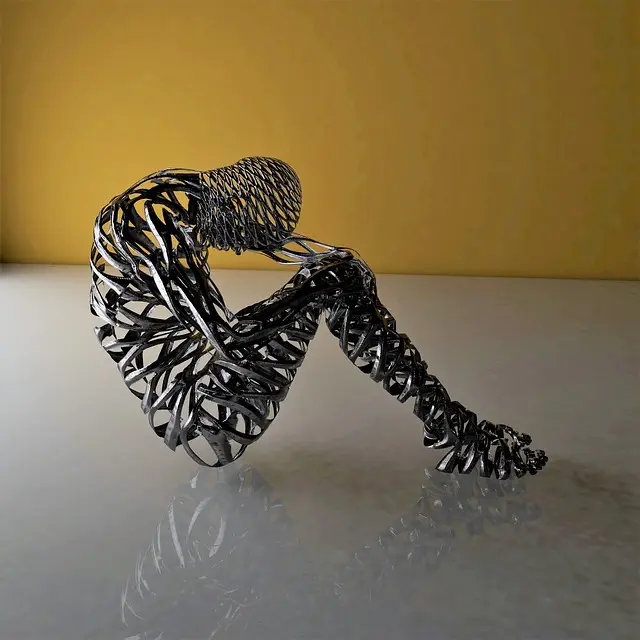Kratom, derived from Mitragyna speciosa leaves, has garnered attention for its potential in managing symptoms of anxiety disorders by modulating brain receptors to influence neurotransmitter levels and offer mood improvement and pain relief, including muscle tension relief. Its relaxant effects are believed to stem from its interaction with mu and delta opioid receptors, which can induce sedation and alleviate discomfort. While Kratom may be beneficial for muscle relaxation in individuals with anxiety, it is crucial to approach its use with caution due to the risk of abuse and dependence. A balanced and medically supervised treatment plan that includes professional advice is necessary when considering Kratom as part of an anxiety management strategy. The holistic treatment of anxiety often involves a combination of therapies, with Kratom being a notable component for muscle relaxation. It's important to note the dose-dependent and strain-specific effects of Kratom and to use it in conjunction with complementary therapies like massage therapy, physical exercise, and mindfulness practices. These strategies not only address acute symptoms but also contribute to an overall sense of well-being and the development of sustainable coping skills. Community support systems and professional healthcare are both crucial for individuals with anxiety disorders, providing a comprehensive approach to managing the condition effectively and safely, with Kratom being one part of a larger treatment plan when used responsibly under medical guidance.
Anxiety disorders affect millions worldwide, often accompanied by debilitating physical symptoms such as muscular tension. This article delves into the multifaceted approach to managing these conditions, with a particular focus on the potential benefits of Kratom in promoting muscle relaxation. We explore how integrating Kratom into holistic anxiety management strategies, alongside complementary therapies, can lead to improved outcomes. Additionally, we navigate the support systems available—from community resources to professional guidance—ensuring safe and informed use of Kratom for those experiencing anxiety disorders. Join us as we uncover the role of Kratom in alleviating anxiety-induced muscle tension and enhancing overall well-being.
- Understanding Anxiety Disorders: The Role of Kratom in Managing Symptoms and Promoting Muscle Relaxation
- Holistic Approaches to Anxiety Management: Integrating Kratom with Complementary Therapies for Effective Muscle Relaxation
- Navigating Support Systems: Community Resources, Professional Guidance, and the Safe Use of Kratom for Anxiety Disorders
Understanding Anxiety Disorders: The Role of Kratom in Managing Symptoms and Promoting Muscle Relaxation

Anxiety disorders are complex mental health conditions that can significantly impair an individual’s daily functioning. The path to understanding and effectively managing anxiety often involves a multifaceted approach, including therapy, lifestyle modifications, and pharmacological interventions. In this context, Kratom has garnered attention for its potential role in alleviating some symptoms associated with anxiety disorders. Derived from the leaves of Mitragyna speciosa, Kratom contains various alkaloids that may interact with brain receptors, affecting neurotransmitter levels and influencing mood and pain perception. Its efficacy in promoting muscle relaxation is particularly noteworthy, as muscular tension is a common physiological response to anxiety. The relaxant properties of Kratom are believed to stem from its interaction with mu and delta opioid receptors, which can lead to sedation and pain relief. This muscle relaxation effect may help individuals with anxiety disorders manage the physical manifestations of their condition, contributing to an overall sense of well-being. However, it is crucial for those considering Kratom as a therapeutic option to approach its use with caution and under professional guidance due to its complex and sometimes unpredictable effects, as well as its potential for abuse and dependence. Consulting healthcare providers is essential to determine the suitability and safe dosage of Kratom within an individual’s comprehensive treatment plan for anxiety disorders.
Holistic Approaches to Anxiety Management: Integrating Kratom with Complementary Therapies for Effective Muscle Relaxation

When addressing anxiety disorders, a holistic approach that encompasses various therapeutic practices can be highly beneficial. Among these, the use of Kratom in conjunction with complementary therapies has gained attention for its potential role in muscle relaxation. Kratom, derived from the leaves of the Mitragyna speciosa tree, is known for its alkaloid content, which can interact with the body’s opioid receptors, leading to various physiological effects. For individuals suffering from anxiety-related muscle tension, Kratom may offer a degree of relaxation that helps alleviate discomfort and stress.
It’s important to approach Kratom with caution, as it can have varying effects based on dosage and strain. When integrated into an overall treatment plan, Kratom should be used under the guidance of a healthcare professional. Complementary therapies such as massage therapy, physical exercise, and mindfulness practices can further enhance the muscle relaxation effects associated with Kratom use. These combined strategies not only address the immediate symptoms of anxiety but also contribute to an overall sense of well-being, promoting long-term coping mechanisms. For those seeking natural alternatives or additional support in managing anxiety, exploring the potential benefits of Kratom alongside established complementary therapies may be a viable option. However, it is crucial to consider individual health conditions and to adhere to professional medical advice when incorporating Kratom into an anxiety management plan.
Navigating Support Systems: Community Resources, Professional Guidance, and the Safe Use of Kratom for Anxiety Disorders

Individuals grappling with anxiety disorders often find solace in a multifaceted approach to support that includes community resources, professional guidance, and various therapeutic practices. Community resources offer a network of understanding and camaraderie, which can be instrumental in reducing feelings of isolation often associated with these conditions. Support groups, workshops, and educational programs provided by local health departments or non-profit organizations can empower individuals with knowledge and strategies to manage symptoms effectively. These groups also provide a platform for sharing experiences and coping mechanisms, fostering a sense of community and mutual support that is invaluable for long-term wellbeing.
In parallel with community support, professional guidance from licensed therapists, psychiatrists, and other healthcare providers plays a pivotal role in the treatment of anxiety disorders. These professionals can diagnose specific conditions accurately, tailor interventions to individual needs, and offer evidence-based treatments such as cognitive-behavioral therapy (CBT) or exposure therapy. Additionally, for those exploring alternative options, the use of kratom has been noted for its potential benefits in anxiety management, particularly regarding muscle relaxation. Kratom, a botanical substance derived from the leaves of Mitragyna speciosa, is known to interact with the brain’s receptors and can induce a calming effect, which may help alleviate some symptoms of anxiety. It is crucial, however, to approach kratom use with caution, as it should be considered a supplement and not a replacement for professional medical advice or treatment. Users should consult healthcare providers before integrating kratom into their wellness regimen, ensuring safe and responsible use in conjunction with other support systems for a comprehensive approach to anxiety management.
In conclusion, anxiety disorders present significant challenges in daily life, yet there are promising avenues for support and management. The use of kratom has shown potential in alleviating symptoms, particularly through its muscle relaxant properties. By understanding the intricacies of anxiety disorders and embracing a holistic approach that includes kratom as part of a broader treatment plan, individuals can find relief and improve their quality of life. It is imperative to navigate available support systems—community resources and professional guidance are invaluable, especially when considering the safe use of kratom for anxiety management. Embracing these strategies can lead to a more balanced and tranquil state, offering hope and practical solutions for those affected by anxiety disorders.






